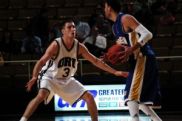by Joe Ashcraft
(Alaska)

Basketball Drills
Many of these basketball drills suggestions make sense.
However, I believe that if you watch any level of the game and study shooting you will notice that the following empirical truths.
1. Watching George Lehman shoot from the back, you will see that his body rotates counter-clockwise – DOES NOT STAY SQUARE at all.
His right foot is turned in slightly, left foot out slightly as he lifts off the floor, so that the elbow stays pointed at the basket easily and extends straight at the basket, not rotating to stay in line; not pinched into the center of the body unnaturally.
If you watch say Kobe Bryant, even when he leaves the floor out of position, the feet rotate into a position where the right foot is pointing across the body line, and the shoulders are never “Square to the basket”
The right shoulder is much closer to the basket, the left is back and rotates further back as the right shoulder leads the upper body in its turn toward the basket.
Michael Jordan took a few years to learn this. But observe his right toe and where it is pointed before he leaves the floor on nearly all shots.
Novistky’s best shot is the fadeaway jumpshot, rotating clockwise.
Take a look at his feet – almost 90 degrees to the basket as the ball is released. Left foot almost directly on the shooting line with toe pointed almost 90 degrees.
Watch the good free throw shooters – Ginobili. Novitski, others.
Either their preferred foot points at the corner, or they line up to the non-preferred side of the nail, so elbow naturally stays in line with hand and basket.
Toe knee shoulder wrist finger – all in natural relaxed, not forced line as has to be when feet are square, shoulders are square.
If preferred foot is on or even to one side of the nail, then the feet might even look square on the free throw line, but they are rotated in relation to the rim and the shooting line.
So the shoulders should not be square, the toes (feet) should be pointed somewhere to the non-preferred side and there should be a whole body rotation in that direction to facilitate a proper follow through.
Without the rotation, you will see the non-preferred foot kick forward at the end of the shot in order to maintain body balance.
If this is happening, and you see it especially in girls with poor technique, you will have a person with little range who will be by the end of a game “passing the ball” at the basket rather than “shooting it like a dart”.
2. In order to gain rhythm, it is better to start the shot with the preferred foot back of the non-preferred foot, and have the non-preferred foot in the air as the pass is thrown.
That foot is planted as the ball is picked or blocked with the non-preferred hand and transferred to the shooting pocket where the preferred hand is already in position to shoot.
As the non-preferred foot comes down, the knee bends and the body sinks; the preferred leg comes forward with the knee bent and leading and rotates the hips and body, and the foot is planted solidly with the toe slightly inward, to allow the knees to extend and deliver the upward impetus for the shot.
Probably the best angle for the toes and feet is about 45 degrees off the line to the basket. But more flexible people most of the time will be more comfortable with a little less, because the elbow and arm can be more easily brought toward the centerline of the body.
More heavily muscled people may need to line the feet at slightly more than 45 degrees to get the most comfortable alignment with the preferred shoulder and elbow.
Whether off the dribble or off the pass, or off a fake, or off the rocker series, one will see the college and pro players follow this sequence if they are a good shooter.
People who have a higher release and an elevated elbow need less body angle a la Derek Fisher. People with a lower release, and on free throws, etc, and farther from the basket need more.
3. The “SQUARE UP THE SHOULDERS” has caused more inefficiencies in shooting, and more damage from untrained shooting coaches than any other thing in basketball.
Joe Ashcraft
Ketchikan Alaska
907 723 5092
